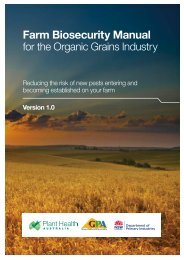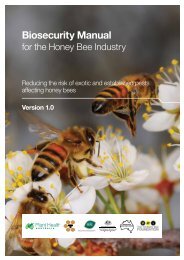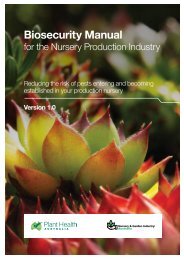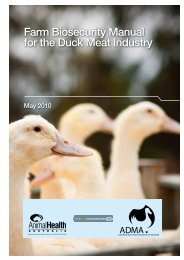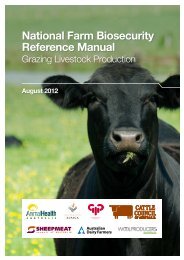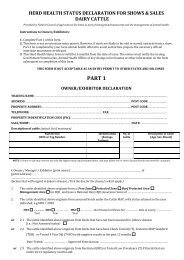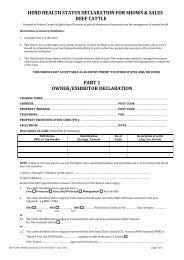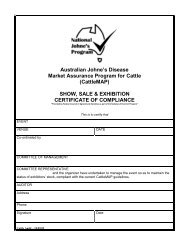Orchard Biosecurity Manual for the Mango Industry - Farm Biosecurity
Orchard Biosecurity Manual for the Mango Industry - Farm Biosecurity
Orchard Biosecurity Manual for the Mango Industry - Farm Biosecurity
Create successful ePaper yourself
Turn your PDF publications into a flip-book with our unique Google optimized e-Paper software.
The definition of a pest used in this<br />
manual covers all insects, mites,<br />
snails, nematodes, pathogens<br />
(diseases) and weeds that are<br />
injurious to plants, plant products<br />
or bees. Exotic pests are those not<br />
currently present in Australia, while<br />
established (and endemic) pests<br />
are those present within Australia.<br />
What is orchard biosecurity?<br />
<strong>Orchard</strong> biosecurity is a set of measures<br />
designed to protect a property from<br />
<strong>the</strong> entry and spread of pests. <strong>Orchard</strong><br />
biosecurity is your responsibility, and that<br />
of every person visiting or working on<br />
your property.<br />
Through <strong>the</strong> implementation of orchard<br />
biosecurity measures, growers play<br />
a key role in protecting <strong>the</strong> Australian<br />
mango industry from exotic pests.<br />
If a new pest becomes established in<br />
your orchard, it will affect your business<br />
through increased orchard costs<br />
(<strong>for</strong> monitoring, cultural practices,<br />
additional chemical use and labour<br />
to apply <strong>the</strong>m), reduced productivity<br />
(yield and/or quality reductions) or<br />
loss of markets.<br />
Early detection and immediate reporting<br />
of an exotic pest increase <strong>the</strong> chance of<br />
effective and efficient eradication.<br />
Regional biosecurity<br />
To streng<strong>the</strong>n <strong>the</strong> biosecurity measures<br />
implemented on your property, consider<br />
including biosecurity issues and activities<br />
in community or regional meetings.<br />
Through this collaborative approach,<br />
biosecurity threats to all properties in<br />
your region can be minimised.<br />
Potential sources of biosecurity threats<br />
may be neighbouring orchards<br />
(operating or abandoned), nurseries,<br />
o<strong>the</strong>r commercial plantings, native<br />
vegetation and/or peri-urban residential<br />
or amenity plantings.<br />
Promotion of biosecurity at <strong>the</strong><br />
regional level is enhanced through<br />
broad engagement of <strong>the</strong> community,<br />
understanding <strong>the</strong> region’s vulnerability,<br />
<strong>the</strong> source and nature of threats,<br />
knowledge of <strong>the</strong> expertise base and<br />
resources available to <strong>the</strong> region,<br />
toge<strong>the</strong>r with a commitment from<br />
stakeholders to implement biosecurity<br />
measures, surveillance and reporting.<br />
Implementation of orchard biosecurity<br />
underpins regional biosecurity, which<br />
in turn underpins national biosecurity.<br />
If orchard measures are supported by<br />
community based measures, a regional<br />
framework <strong>for</strong> biosecurity can be<br />
coordinated and is achievable.<br />
5



